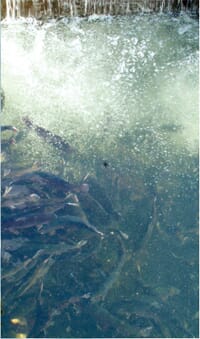 |
This bulletin is designed to assist with timing and planning of the AquaVac ERM oral booster vaccine. The vaccine is provided by Schering-Plough Animal Health as part of the company’s Total Protection Strategy. If you would like any further information please contact your local Schering-Plough representative.
Planning the Timing of the oral vaccination booster
Vaccine timing
Aqua Vac ERM oral vaccine is designed for use as a booster†† to immunity, given 4-6 months following primary vaccination with AquaVac ERM immersion. It is intended to extend the protection induced by the primary immersion vaccination.
The initial immersion vaccination with AquaVac ERM provides protection for up to 6 months post vaccination. In common with most animals the immunity provided to the rainbow trout requires periodic boosting to maintain high levels of protection. AquaVac ERM oral booster vaccine provides increased protection from ERM through to the end of the rainbow trout’s production cycle.
In order to maximise the success of booster vaccination it should be administered at the correct time. A number of factors determine the ideal timing.
Of these the most important are:
- The ERM disease cycle on the farm;
- Health status of the fish during primary vaccination and at the time of boosting;
- Water temperature at the intended time of booster vaccination;
- Nutritional status of the fish at the time of booster vaccination.
1. ERM disease cycle
The level, prevalence and severity of ERM infection and subsequent clinical disease vary from farm to farm. Many factors influence the exact cycle, but in general terms location, seasonal variations in water temperature and water quality, and presence of wild carrier fish in the water course will have an impact, as will the farm stocking and production programs.
Understanding the disease cycle from past records is essential in optimizing the protection provided by the vaccination strategy.
The ERM disease cycle on farms can broadly be categorised into 2 broad types:
- ERM disease endemic throughout the year.
- Distinct seasonality with disease risk following the temperature profile of the site. The main risk is usually in the Spring and Autumn with rising or falling temperatures, but may also run through the summer on some sites.
Tables 1 and 2 in this bulletin show how vaccination booster timings can be adapted to suit sites with the above disease profiles.
The objective in determining the optimum timing for the booster vaccination is to ensure that the maximum level of protection is achieved before the start of the period of highest risk of the disease.
The normal recommended interval is 4 – 6 months following immersion prime.
- In the case of a farm suffering a major ERM risk during the Summer (June/July) the target booster date for all fish on the site would be Spring (April). This ensures that all fish have optimum protection through the period of highest risk.
The sites with ERM throughout the year will not boost until 4 to 6 months later because they need protection beyond just the summer months. - Sites with endemic year-round ERM are recommended to follow the 4 – 6 month interval from primary vaccination. This will maintain high levels of protection whilst also maximising the duration of the protection thereby covering the fish throughout the production cycle.
2. Fish health
Only vaccinate healthy fish.A strong immune response to vaccination can only take place when an animal is in good health. In the case of fish populations with large numbers of individuals it is the health status of the population that is important. In judging this the key parameters to be considered are:
- There should be no acute mortality;
- The population should not have suffered chronic mortalities in the lead-up to vaccination;
- The population should be feeding and growing normally;
- The population should already be well graded, in the tanks where the oral vaccine will be fed and not in need of moving or grading for at least 200 degree days after administration of the booster.
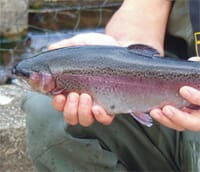 |
This advice pertains both to disease caused by pathogens (bacteria, parasites or viruses) and environmental diseases.
There are some specific disease situations that have to be considered which can cause particular problems with successful vaccination.
Rainbow Trout Fry Syndrome (RTFS)
This disease is caused by Flavobacterium psychrophilum and in addition to causing direct losses has a major effect on the immune organs of rainbow trout. Among other pathology it causes damage to the head, kidney and spleen, both important immune organs. It is most prevalent in small fry (between 0.5 – 10 grams) and can then have a major impact on the response to the immersion primary vaccination. If it occurs in larger fish being booster vaccinated, it will also have an adverse effect on the immune response, reducing both the level and duration of protection.
ERM
If the fish are infected with ERM then they should not be vaccinated. An antibiotic treatment should be given to cure the problem before vaccination and then extra care must be taken to avoid stress during and immediately after the vaccination process.
In general terms, preparing the fish for vaccination is critically important. When they are at risk from husbandry stresses, these should be reduced (stocking density, grading and moving). When the population is suffering from a treatable disease it should be treated and cured before vaccination. Where the problem is not treatable (e.g. poor water quality or viral disease) the best husbandry and nutritional practices should be implemented to get the population back to good health prior to vaccination. Stress is an associated factor in fish health, whether manifested through disease or incorrect handling and can dramatically limit immune response and lower the threshold to which fish will become susceptible to clinical infection.
Therefore to ensure optimal immune response, stress should be kept to a minimum.
If you have concerns regarding the health of fish at the time of planned booster vaccination, please contact your specialist fish vet or Schering-Plough Animal Health representative.
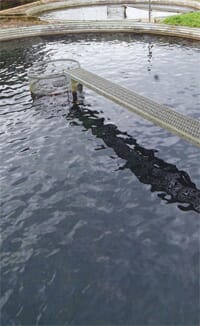 |
3. Water temperature
Having considered the disease cycle to determine the optimum time to administer the booster vaccination, and the health status of the fish to be vaccinated, it is critical they are physiologically capable of responding to the vaccine. The key factor in determining this is the water temperature leading up to, during and for the 20 days after vaccination. Temperature has a major effect upon the speed of immune development, which is why immune induction is normally expressed as degree days (i.e. daily temperature multiplied by the number of days). However, minimum and maximum temperatures must also be considered. If the temperature falls below 6°C, the immune response may be significantly truncated. If it rises too high (e.g. 18-20°C), then the stress and stress-related hormones could reduce or stop the development of protective immunity. If the temperatures are outside the acceptable range, then the fish should not be vaccinated using the oral vaccine.
Careful calendar planning of the primary immersion vaccination programme should present fish for booster vaccination at times when temperature ranges fall within the recommended levels for the booster.
4. Nutrition
Vaccination strategies can be adapted to suit the environment in which different sites operate.
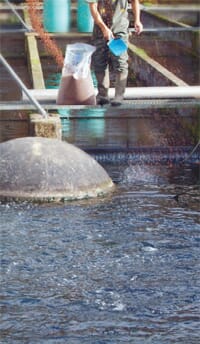 |
- Farm with a colder water profile
- Farm with a shorter cold water period
Nutritional preparation and control are important conditioning factors for rainbow trout prior to vaccination with AquaVac ERM oral vaccine. Trout fed to their required intake levels, commensurate with their age and environment, should have developed the necessary immune response levels essential for successful vaccination.
As a guiding point it is recommended that you check the feed diet and intake levels both prior to and post vaccination.
AquaVac Ergosan* is a complementary feedstuff made from seaweed. It is used to optimise the nutritional status of the fish prior to the oral vaccination, to ensure it is in the best possible condition for optimal immune response to the vaccination. Its use is highly recommended by Schering-Plough Animal Health Aquaculture and is considered an integral part of the Total Protection Strategy.

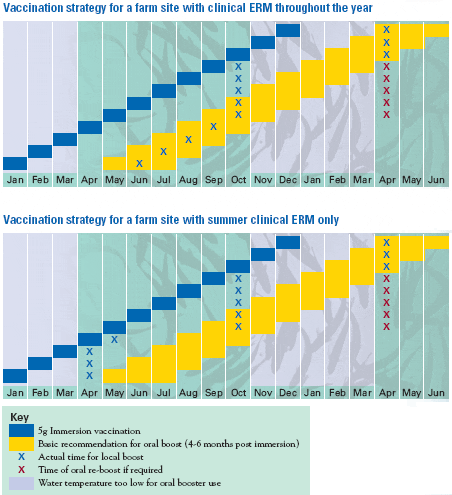
March 2007

